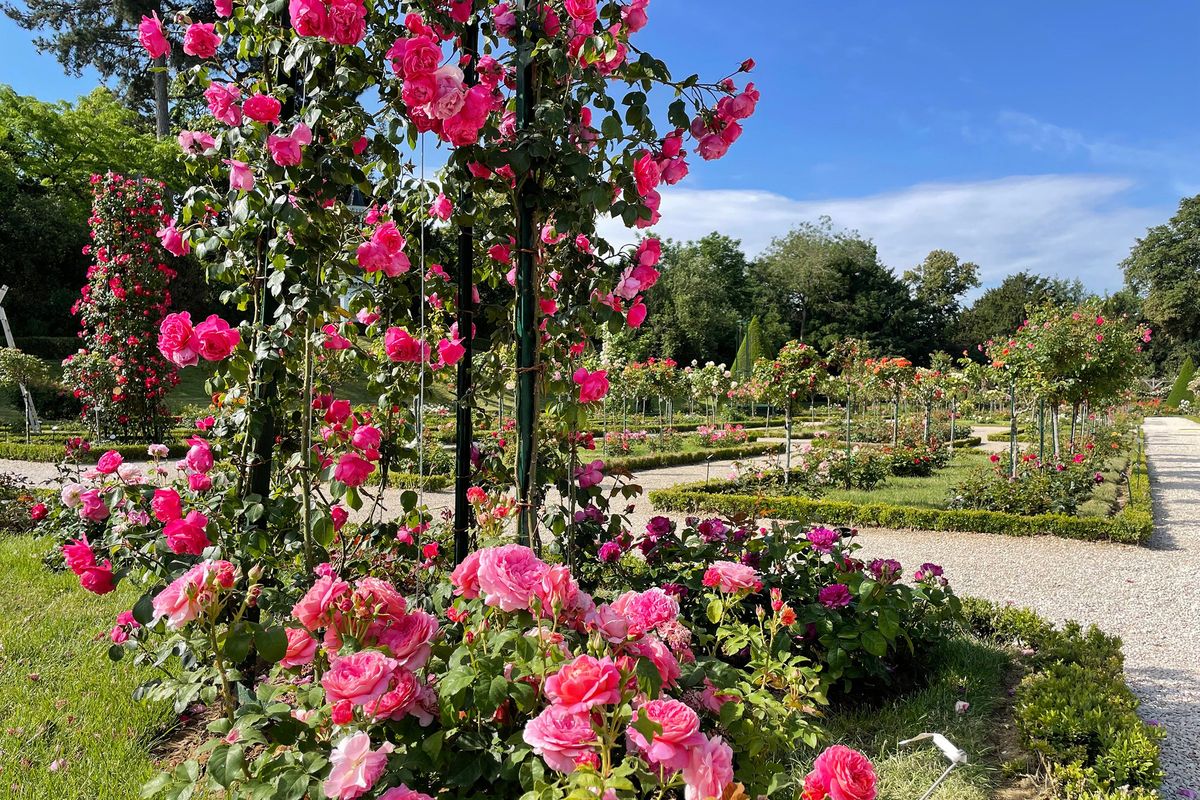From The Spokesman-Review:
In Paris, it’s the season for rose sniffers. As the days lengthen toward the summer solstice, the city’s roses unfurl their petals in an exuberant palette: coral, apricot, wine-red, lavender, sunny yellow. The colors are irresistible, but it’s really the scent that gives them away. The unmistakable perfume wafts over the cityscape and, for a brief moment, disguises less savory urban odors, luring passersby to plunge their noses into the roses and inhale with gusto.
These blooms aren’t just found in the major gardens, such as the Jardin des Plantes and the Parc de Bercy, with their dedicated rose gardens. Roses climb up old stone walls, brighten small squares and even perfume the Roland Garros stadium, where the French Open tennis tournament is held. But the best place to admire the “queen of flowers” is the Parc de Bagatelle, a western wonderland abutting the Bois de Boulogne that’s remarkably untouristed. In fact, I first visited Bagatelle only after a decade of living in Paris, and the taxi driver – when I alighted at the Pont de Neuilly metro stop – had never heard of my destination. (He resorted to GPS to navigate the remainder of the distance, which was less than 2 miles.)
While tourists have returned in full force to Paris, with crowds thronging the major monuments in the city center, Bagatelle offers intriguing heritage, a chateau born of a bet with Marie Antoinette, and 59 acres of verdure about 5 miles from the Notre-Dame cathedral. Not to mention the riot of roses: One of four locations for the Paris Botanical Garden, Bagatelle is planted with 10,000 rose bushes representing 1,200 varieties. This oasis is so alluring that some rose rustlers have even been caught sneaking clippings.
It’s here in the classic rose garden where the International Competition for New Roses assembles a jury of experts – professional perfume “noses” and passionate enthusiasts – to judge new rose varieties in June. Established in 1907 as the world’s first such competition, it’s open to both amateur and professional breeders of noncommercialized roses. The competition has been canceled only once (during the Liberation of Paris in 1944), but coronavirus challenges meant adapting to virtual voting. Naturally, there’s a lot of excitement about the return of the in-person event. Alongside the garden’s strutting peacocks, the notebook-wielding jury members sniff and scope their way through the alleyways, the noses among them decrypting the precise litchi, citrus and clove notes of the flowers.
“Not only can breeders present their new varieties and see how they thrive here in Paris, but it’s also a showcase for the public to see the evolution of the rose: the new colors, the new shapes,” says Jean-Pierre Lelièvre, the head of horticulture for the Bois de Boulogne.
There’s a universal fascination with the rose. Laden with symbolism, it sprouts in literature and legend, including from Persian poets and bards of English literature. Indeed, the rose is rooted in the very soil of culture: It conjured divine paradise in the tombs of ancient Egypt; bloomed in ancient Greek legends; symbolizes “eternal spring” in China, where roses have been grown for 5,000 years; and represents the Virgin Mary for Catholics. The term “rosary,” explains novelist Alexander Chee in an essay of the same name, once meant rose garden in Middle English, and later became the term for prayer, associated with a “circlet of roses” offered to the Virgin Mary.
“Flowers are linked to our personal journey, from birth to death, and we’re instinctively drawn to the rose because it elicits emotions,” says Amy Kupec Larue, a garden guide and permanent jury member of the Bagatelle rose competition. “It’s a noble flower, elevated to a different category. You pick daisies. You cultivate roses.”
Undoubtedly, the allure is enhanced by the plant’s perfume and the memories grafted to our sense of smell. “In France, we have memories of roses in our parents’ gardens tied to the fragrance,” Lelièvre says. “The fact that these flowers give off an extraordinary scent contributes to their fame.”
Then there are the names, as poetic as the sagas behind them. Belle Hélène, York and Lancaster, Cuisse de Nymphe and – the oldest and perhaps most storied in France – the rose of Provins. It’s said that it was first brought back from the Crusades in the 13th century by Thibaud IV of Champagne, and – grown for perfume and medicinal remedies – contributed to the prosperity of Provins, now an immaculately preserved medieval town and UNESCO World Heritage site about an hour from Paris.
But we really owe the French rose fad to a 19th-century trendsetter. Empress Joséphine Bonaparte amassed a collection of roses at the Château de Malmaison, about 5 miles west of Bagatelle, that awed visitors from all over the world. (On the bicentennial of her death in 2014, the chateau revived her garden of heirloom roses and introduced a new rose, “Souvenir de Joséphine.”) Roses were a part of Joséphine’s daily routine, perfuming her rooms and even adorning her dresses. Famously, she commissioned the painter-botanist Pierre-Joseph Redouté to illustrate a book of roses, a seminal work whose beautiful engravings remain in demand.
The origins of Bagatelle are linked to another rose fanatic, Queen Marie Antoinette. In 1777, she placed a bet with her brother-in-law the Count of Artois, who had recently acquired a country house in the woods between Versailles and Paris: Could he build a chateau worthy of a queen while the itinerant royal court traveled to the Château de Fontainebleau? Not about to lose the wager, the count enlisted about 900 workers and even confiscated building materials to complete it in just 64 days. The petite pleasure palace was designed for trysts and entertainment away from the nosy court, its neo-Palladian facade inscribed with the Latin phrase “Parva sed apta” (small but well designed). (Read more.)
More pictures, HERE. More information, HERE.




















No comments:
Post a Comment